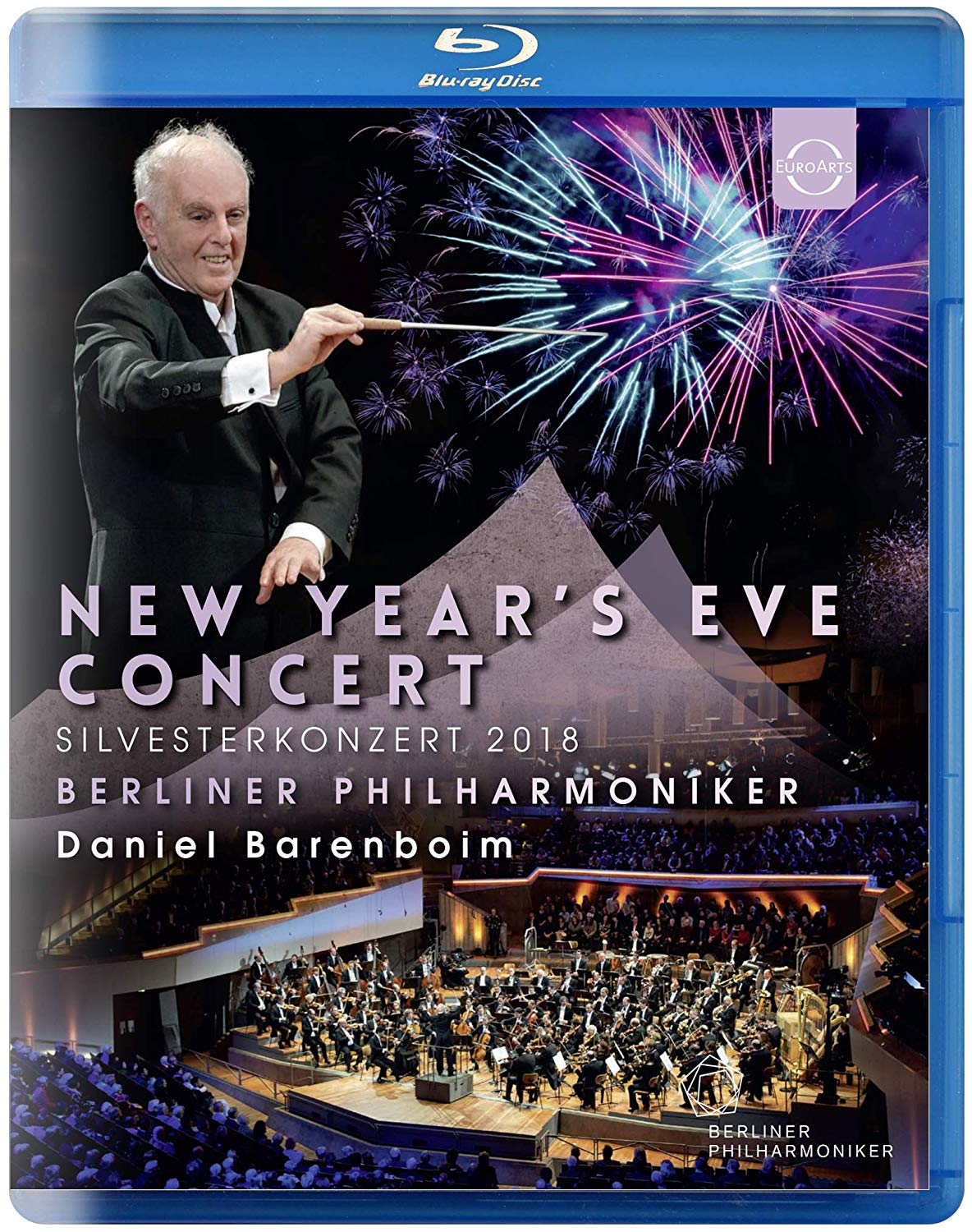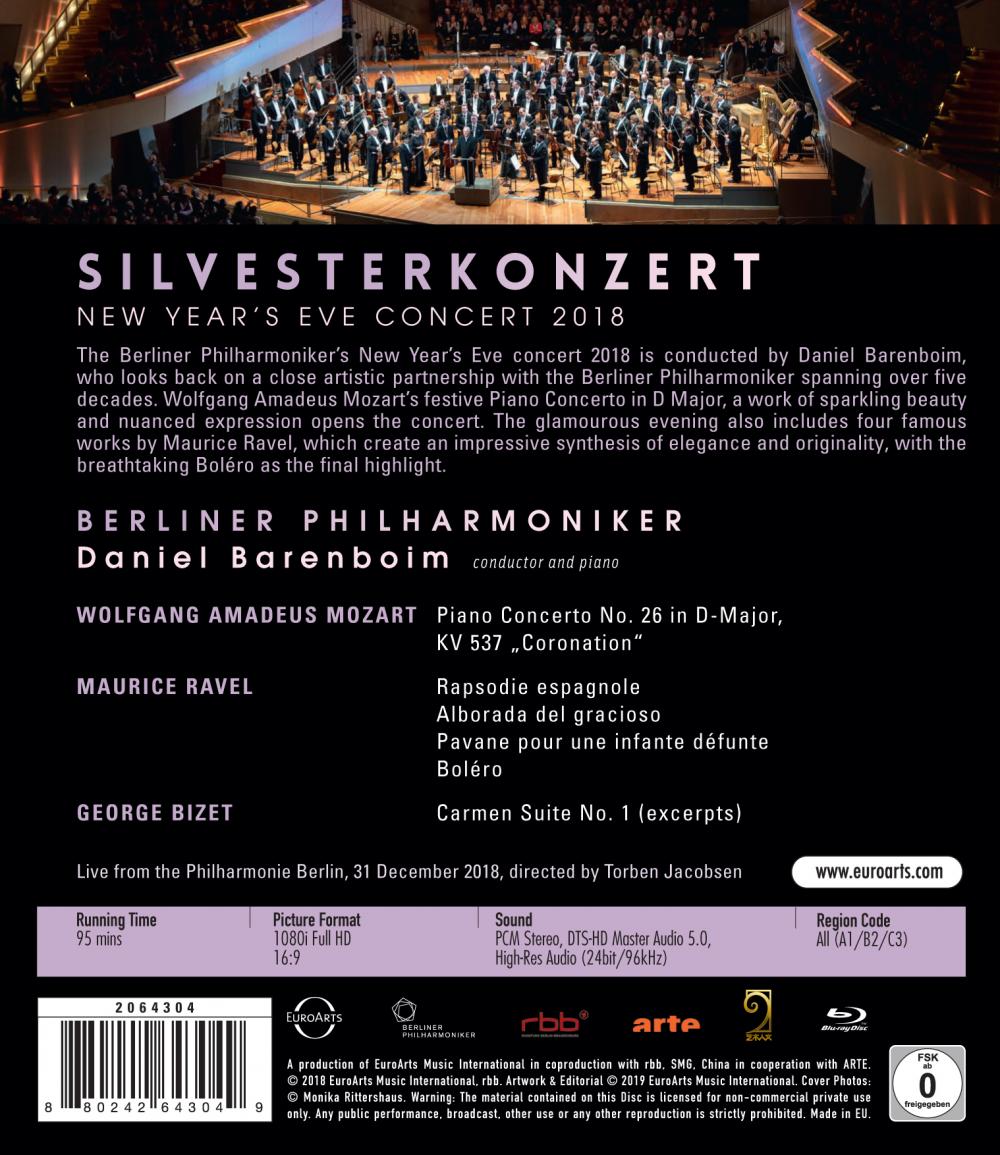

2018 New Year's Concert a/k/a Silversterkonzert by the Berliner Philharmoniker. Daniel Barenboim conducts and is piano soloist at the Berlin Philharmonie on the last day of 2018. Here is the program:
Mozart Piano Concerto No. 26 “Coronation”
Ravel Rapsodie espagnole
Ravel Alborada del gracioso
Ravel Pavane pour une infante défunte
Ravel Boléro
Bizet Carmen Suite No. 1 (excerpts)
We only cover gala and New Year’s concerts if the program is substantial (not just pops, marches, polkas, and waltzes). This program is attractive, and we were also encouraged to see that the sound file was recorded with 96kHz/24 bit sound sampling. Directed for TV by Torben Jacobsen. Released 2019, the disc has 5.1 dts-HD Master Audio sound. Grade: C+
Wonk Bryan Balmer reviewed the entire disc. He made screenshots from the Bolero only. Bolero starts off with a reasonable shot of the snare drum embedded between the cellos and woodwinds (rather than playing from the back of the orchestra where the percussion section resides):
Then the camera quickly moves to instrument-only range to no benefit:
Rather than zoom in, the camera should zoom out so the viewer can better see the unusual location of the instrument. The shot below comes later in the piece, and in it you can see the unusual location of the drum:
Similarly, the opening flute solo starts at a nice multiple-section level of zoom:
But moves to a typical solo shot:
Daniel Barenboim does not do any conducting throughout the majority of Bolero. The orchestra doesn’t need a timekeeper — they have their own heartbeat above which the soloists are free to take their own liberties. Very effective!
Barenboim comes to life in the latter parts of the piece!
A nice multi-section shot:
Sometimes the small scale shots work well, but they are tricky to capture. Here is one good one:
And one not so good:
We get some of our best shots during the applause:
A smile from the maestro!
Balmer also ”ran the numbers” on Bolero to help judge if this title is infected with DVDitis. In our special article about DVDitis we arrive at the follow tests for the dread disease:
“A good HDVD should have a slow pace with more than 10 seconds per video clip on average (longer the better). 20 to 40% (higher is better) of the clips should be large-scale "supershots" (whole-orchestra, part-orchestra, multiple-section, and large-section shots). Conductor shots should be less than 20% (way less really) of the clips in the video.”
Now you can see what the “Bolero” statistics show in the table below. To get the pace, just divide the length of the test music by the number of clips in the video:
| Ravel - Bolero | |
| Duration | 14:05 |
| Pace | 8.8 s per clip |
| Supershots | 19.8 % |
| Conductor | 12.5 % |
| Instrument Only | 17.7 % (17 shots) |
Now let’s grade the Bolero segment. Start with A+ (has 96kHz/24 bit sound sampling). We will assume performance, SQ, and PQ are all excellent. Deduct for the too-fast pace to B+. Supershots are marginal, so let's drop to B. The large number of Instrument only shots warrants a further downward drop to C+. Maybe that's a bit harsh, but Balmer reports his overall impression of the entire disc that this isn't a "B" title. So another one bites the DVDitis dust.
Just for fun, I counted 14 segments in the YouTube trailer for this title. The trailer has a total of 126 seconds, which yields a pace of 9 seconds per clip, which flunks the pace test. There are 4 supershots in the 14 for 28%, which passes the supershot test. But 28% of the video is devoted to conductor shots, which is another flunk. The trailer may or may not represent the whole video faithfully, so these numbers don’t carry much weight. But the clips in the trailer do in fact support the diagnosis of DVDitis.
Here's the official trailer:
OR














